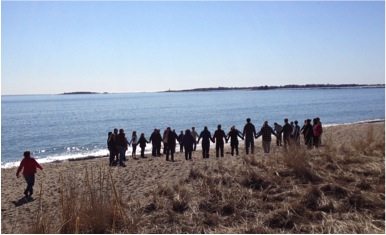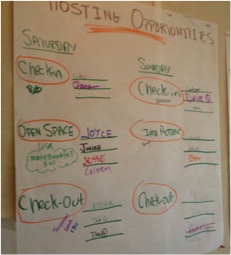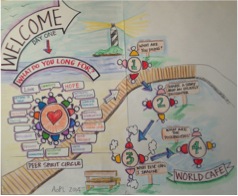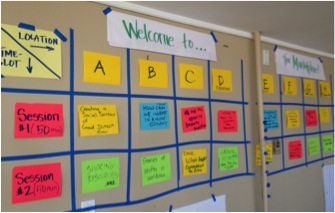I had the opportunity to participate in a gathering called The Art of Participatory Leadership, which is defined as “an intensive 3-day event where you experience and practice a set of simple, yet powerful, processes for building community, facilitating powerful conversations, building strong partnerships, and leading change.” While I have experienced several of the approaches before, such as World Café, what I discovered was that when a group is together for several days in this kind of generative space there is a fundamentally different quality and impact of the experience. In contrast, the typical way that meetings are structured (e.g., a tight agenda focused on efficiently reaching desired outcomes) feels like a constraining straightjacket in terms of how much creativity, connection and innovation is actually possible within any group.
Reflections from the Art of Participatory Leadership Gathering April 2014 in Saco, Maine
I was struck by how the values and design principles of Art of Hosting are the same principles of working in networks and of creating sustainable resilient communities, as the highlights below will illustrate. (As background, this gathering was sponsored by Transition Towns US and many of the participants were working to create vibrant sustainable local communities. We had about 45 people mostly from the northeast US and it ran from Friday at 4pm to Sunday at 4pm.)
Here are some of the qualities of what I experienced that were highlights:
 Returning to the circle – We began the event sitting in a circle and returned to this circle multiple times. The emphasis was that the learning is in the center and we all have something to contribute to that learning (instead of the frame that the expert at the front of the room has the answers and participants sit in rows listening.) The times when we heard from everyone and the way we could see everyone in the circle created a sense of community and being part of a larger whole where all voices could be heard.
Returning to the circle – We began the event sitting in a circle and returned to this circle multiple times. The emphasis was that the learning is in the center and we all have something to contribute to that learning (instead of the frame that the expert at the front of the room has the answers and participants sit in rows listening.) The times when we heard from everyone and the way we could see everyone in the circle created a sense of community and being part of a larger whole where all voices could be heard.- “The shortest distance between two people is a story.” This quote from Meg Wheatley kept resonating with me through the weekend as I saw how the opportunity for people to share stories created a growing sense of trust and camaraderie among the group. A World Café with three rounds the first night enabled people to get to know each other, hear the stories of many other participants, and begin finding and connecting common interests.
- Beauty – The event was held at Ferry Beach Conference Center, right across the street from the Atlantic Ocean in Saco, Maine. The beauty of the surroundings and opportunity to take a break from the conversations and walk on the beach added to the experience, as did the delicious food, and the drawings of Deb Barth, an artist who created colorful images of our conversations.
 Participants participate in hosting the gathering – Participants were invited to help “host” various parts of the gathering, including a check-in and check-out each day. This offered an opportunity for various people to share their skills and creativity, embodying the ideas that we all have something to offer, we can all contribute to the gathering, and we can show up in various roles in a group at various times.
Participants participate in hosting the gathering – Participants were invited to help “host” various parts of the gathering, including a check-in and check-out each day. This offered an opportunity for various people to share their skills and creativity, embodying the ideas that we all have something to offer, we can all contribute to the gathering, and we can show up in various roles in a group at various times.- Mixing of conversational scales, seeded with content: Throughout the gathering, we smoothly shifted from large group conversations, to small groups, to pairs or triads, and back to the large group. Each scale of conversation has it’s own flavor and having the space and time to mix the format continually among these was so valuable (and fun.) This mixing of conversations was fertilized with frameworks and ideas to spur our thinking and reflections, such as the Two Loops Theory of Social Innovation and exploring our world views, which were shared by several of our hosts: Jerry Nagel, Tenneson Woolf, and Bob Stilger.
- “Design for serendipity” – When meetings are tight on time and strictly wedded to a fixed agenda, there is little space for serendipity that enables new things to emerge. Saturday afternoon we did Open Space where we had two rounds with about 8 topics each, suggested by participants. People could join the conversation topic where they felt drawn and connect with others who were interested in the same things. Or they could take a nap or go for a walk. By the afternoon of the second day, it felt like all this interweaving of people, stories, ideas, art, music, good food, and beautiful views created this big soup, a quality of space that was humming with good will, appreciation, inspiration, ideas and deeper understanding, and a sense of possibility.
Surprising serendipities and fun coincidences started happening, e.g., on Saturday morning, I remembered a poem that felt appropriate for the conversations we were having. I wrote it out on a flip chart and thought I would post it on one of the walls. Just as I finished writing it, we began the day’s conversations. One of the facilitators extended an invitation for people to offer poetry and other “harvests” of ideas into the room. I raised my hand and said I had just written a poem to offer.

- Small world reach – Amidst so many conversations, the sharing of connections, resources, and ideas was amplified. This scenario happened a lot: I mentioned being interested in something to a dinner companion, who would say, you need to talk to [this person] as they are interested in the same thing. Or they would suggest a resource or idea that could help me build on my idea. This format enabled this “small world reach,” where people find and engage with others interested in similar things. The Knowledge Camp on Sunday morning offered two rounds on conversations in small groups with a variety of topics to choose from. People could gather at the topic they were interested in and the hosts introduced some concepts/stories and then shifted it into a lightly facilitated conversation among those in the group. These formats quicken our ability as one participant put it “to discover the adjacent possible.”
- Surfacing latent wisdom – One of my favorite moments was after a small group conversation when we were sharing back in the large circle. One participant shared a quote that Susan, in her group, had said that she found meaningful. Susan quickly exclaimed “I said that?” surprised by her own wisdom perhaps. People had profound insights, powerful stories, and so much wisdom. In most gatherings this is latent, yet with this format, so much more of this could be accessed by creating the space to have real conversations and listen to each other.
Something about the spaciousness and respect for people to offer things and do what they wante
d was deeply moving to me. I felt I could be relaxed and be in a community where people appreciated what I could offer and I was continually learning, expanding my thinking, finding inspiration and new possibilities in my interactions with others in the group.
Next, I want to explore the potential of hosting a gathering like this with participants who are all working in a similar place or issue, e.g., imagine gathering people from all parts of a state’s food system or creating a gathering that brings together people working on climate action with those working on environmental justice and/or new economy, where there can be a big interweaving of ideas and connections. I think this process can accelerate collective work in networks and greatly amplify peer-to-peer knowledge exchange.
I agree with my colleague, Madeline Snow, who I’m grateful to for introducing me to with Art of Hosting: “The real work doesn’t just happen in your office, it happens in these gatherings.”

Beautiful reflections Beth. Thank you. You have a gift to be able to name these patterns. Great to be with you in this gathering.
PS: Had a great afternoon Monday with Adam. 🙂
Beth, you’ve done a wonderful job of describing an almost indescribable event! Thanks for the photos and insights. It was terrific meeting you and so many other kindred spirits!